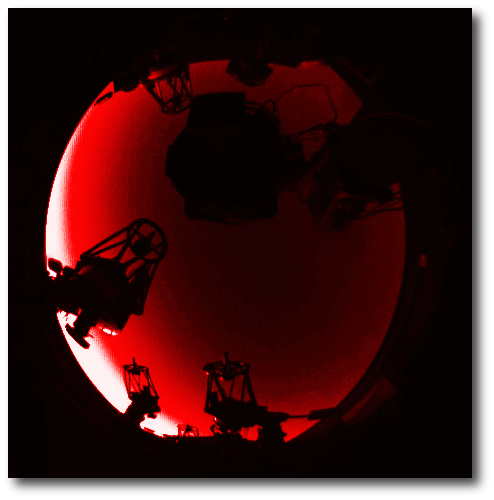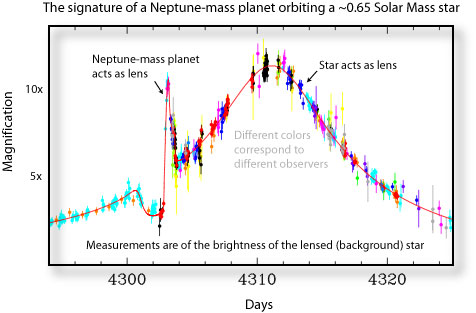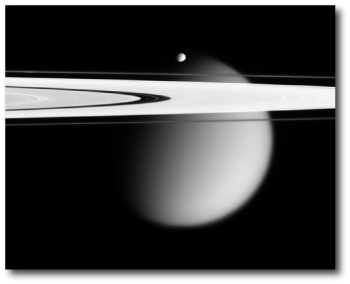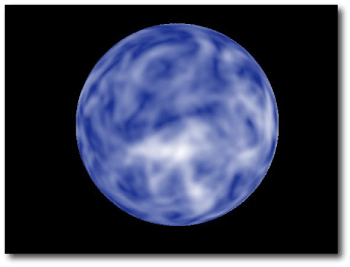
Several readers pointed out that the terrestrial planet valuation formula breaks down dramatically for Venus. Point taken! I’m not sure though, that a top-dollar Venus necessarily points to a flaw. The valuations are a quantitative measure of potential for a planet to be habitable, given only bulk physical properties currently measurable across light years of space. One is still faced with the quandry of whether to invest in to finding out whether a given planet measures up. If Venus were sheathed in water clouds rather than sulfur dioxide clouds, it would quite possibly achieve its potential as a quadrillion-dollar world.
At any rate, given its sky-high atmospheric D/H ratio, it’s not inconceivable that Venus was both habitable and inhabited, at least by microbes, in the distant past. Under the constraint of a zero-sum budget for solar system exploration, I would agitate for spending more exploring Venus and less exploring Mars.
It’s admittedly gauche to price planets like baseball cards. But it’s also true that taxpayer money, big money, well over a billion dollars of real money, is being spent to find planets, and astronomy has long since departed the ivory tower. We know from direct observation that an excitable media is more than eager to paint habitability-lottery losers in neon shades of blue and green. A middling $158.32 best-yet on a scale that will soon be registering million-dollar worlds underscores the importance of keeping the powder dry.
Which brings up scenario number two for how the first million-dollar detection (and indeed the first hundred-million dollar detection) could arise. It’s extremely likely that the first planets with genuine potential habitability will be detected from the ground. It’s also a good bet that these planets will arise from the same technique that’s produced the overwhelming majority of the big-ticket planet detections to date: Doppler radial velocity. If I were pressed to guess the particular star, I’d choose HD 40307. And if I were pressed to guess the time frame? Sometime within the next year.
The Mayor et al. (2009) HD 40307 paper rewards careful study, and indeed, may end up being as illuminating for what it reveals as for what it doesn’t reveal. In the paper, the evidence for the now-famous planets “b” (Msin(i)=4.2 M_Earth, P=4.3d), “c” (Msin(i)=6.8 M_Earth, P=9.6d), and “d” (Msin(i)=9.2 M_Earth, P=20.5d) is presented in the form of phase-folded plots of the radial velocities, and a periodogram of the velocities prior to any fitting. That all three planets are clearly visible in the raw periodogram is in itself quite remarkable. The orbits are close to circular, the system has been observed for many periods, and the signals (despite the small half-amplitudes) are unambiguous:

The actual radial velocities, however, are not included in the paper, and would-be Dexterers are thwarted by the fact that the only plots showing the full data set are phase-folded. The journal version of the paper reports that the velocities are available at: http://cdsarc.u-strasbg.fr/cgi-bin/qcat?J/A+A/493/639 , but the link is still empty…
In lieu of access to the actual data, we have carte blanche to engage in irresponsible (yet technically accurate) speculations to get a sense for what further secrets the HD 40307 system might harbor. Let’s construct a Monte-Carlo data set. An optimally habitable ten million-dollar planet in the HD 40307 system has a mass of ~2.3 Earth masses, an orbital period of 141 days, and induces a K=0.35 m/s radial velocity half-amplitude. We can make a model system that includes such a planet along with the three known planets (noting that the Mayor et al. 2009 paper contains an error for K_d in Table 2). We can generate a synthetic radial velocity data set by perturbing the four-planet model with the reported 0.32 m/s instrumental measurement error and 0.75 m/s of Gaussian stellar jitter, and observing at 135 randomly spaced times within a span of 1628 days.
We can put the resulting data set into the Systemic Console. Removing the 20-day planet gives a residuals periodogram that clearly shows the 9.6d and 4.3d planets, along with an alias peak at ~2 days. As with the actual periodogram in the Mayor paper, there’s nothing particularly interesting at 141 days. That is, there’s no sign of the ten million-dollar world that was baked into the data.
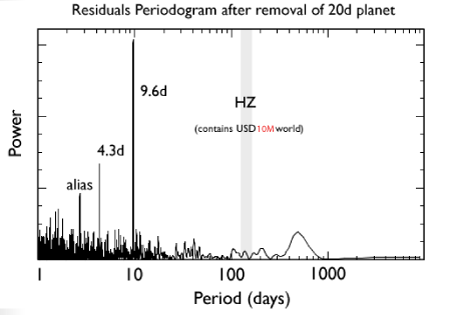
Remarkably, however, when the 9.6d and 4.3d planets are fitted and removed, the periodogram peak for the 141d planet is quite prominent. It’ll be very interesting to see if anything like this is present in the actual data set when it goes online:

It’s straightforward to recover the 141d planet in the orbital fit. Removing the three known inner planets and phase-folding the data at the period of the 141d planet shows what its current (as of last June) signature would look like:

A real planet with these properties would thus be right on the edge of announceability. HD 40307, furthermore, is by no means the only quiet Mv~7 K dwarf in the local galactic neighborhood…
